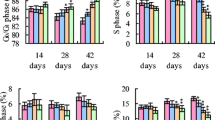Abstract
The purpose of this 42-day study was to investigate the effects of dietary excess vanadium on immune function by determining changes of the subsets and proliferation function of splenic T cells. Four hundred twenty 1-day-old avian broilers were divided into six groups and fed on a corn–soybean basal diet as control diet or the same diet amended to contain 5, 15, 30, 45, and 60 ppm of vanadium supplied as ammonium metavanadate. When compared with those of the control group, the percentage of CD3+, CD3+CD4+, and CD3+CD8+ of splenic T cells were decreased in the 45 and 60 ppm groups; however, the percentage of CD3+ and CD3+CD4+ were increased in the 5 ppm group, and the CD +4 /CD +8 ratios were raised in the 5 and 15 ppm groups at 14 days of age. Meanwhile, the proliferation of splenic T cells were depressed in the 45 and 60 ppm groups but raised in the 5 and 15 ppm groups. Also, the serum interleukin-2 (IL-2) and interleukin-6 (IL-6) contents were decreased in the 45 and 60 ppm groups and increased in the 5 ppm group. It was concluded that dietary vanadium in excess of 30 ppm changed the percentages of splenic T cell subsets and inhibited the proliferation of splenic T cells and reduced the serum IL-2 and IL-6 contents. The cellular immune function was finally impaired in broilers.
Similar content being viewed by others
References
French RJ, Jones PJH (1993) Role of vanadium in nutrition: metabolism, essentiality and dietary consideration. Life Sci 52(4):339–346
Nielsen FH (1990) New essential trace elements for the life sciences. Biol Trace Elem Res 26–27(1):599–611
Uthus EO, Nielsen FH (1990) Effect of vanadium, iodine and their interaction on growth, blood variables, liver trace elment and thyroid status indices in rats. Magnes Trace Elem 9(4):219–226
Anke M, Groppel B, Gruhn K et al (1989) The essentiality of vanadium for animals. In: Anke M, Baumann W, Braunlich H (eds) 6th International Trace Elment Symposium. Friedrich- Schiller-Universitat, Jena 1, pp 17–27
Duckworth WC, Solomon SS, Liepnieks J et al (1998) Insulin-like efects of vanadium in isolated rat adipocytes. Endoerinology 122:2285–2289
Crans DC, Smee JJ, Gaidamauskas E et al (2004) The chemistry and biochemistry of vanadium and the biological activities exerted by vanadium compounds. Chem Rev 104(2):849–902
Domingo JL (2002) Vanadium and tungsten derivatives as antidiabetic agents. Biol Trace Elem Res 88(2):97–112
Norgaard A, Kjeldsev K, Hansen O et al (1983) A simple and rapid method for the determination of the number of H3-ouabain binding sites in biopsies of skeletal muscle. Biochem Biophys Res Commun 111(1):319–325
Bahdan RN (1984) Mechanisms of action of vanadium. Ann RevPharmcal Toxical 24:501–507
Schmitz W, Scholz H (1982) Effect of vanadium in the +5, +4 and +3 oxidation states on cardiac force of contraction, adenylate cyclase and (Na+, K+)-ATPase activity. Biochem Pharmacol 31(23):3853–3860
Bishayee A, Chatterjee M (1995) Time course effects of vanadium supplement on cytosolic reduced glutathione level and glutathione S-transferase activity. Biol Trace Elem Res 48(3):275–285
Liochev SI, Fridovich I (1990) Vanadate-stimulated oxidation of NAD(P)H in the presence of biological membranes and other sources of O -2 . Arch Biochem Biophys 279(1):1–7
Mravcová A, Jírová D, Jančí H et al (1993) Effects of orally administered vanadium on the immune system and bone metabolism in experimental animals. Sci Total Environ 134(1):663–669
Gisela FE, Walter GB, Tina KB (1998) CD4, CD8 and TCR defined T-cell subsets in thymus and spleen of 2-and 7-week old commercial broiler chickens. Vet Immunol Immunopathol 62:339–348
Qureshi MA, Hill CH, Heggen CL (1999) Vanadium stimulates immunological responses of chicks. Vet Immunol Immunopathol 68(1):61–71
Parmentier HK, Kreukniet MB, Goeree B et al (1995) Differences in distribution of lymphocyte antigens in chicken lines divergently selected for antibody responses to sheep red blood cells. Vet Immunol Immunopathol 48:155–168
Ramanadham M, Kern M (1983) Differential effect of vanadate on DNA synthesis induced by mitogens in T and B lymphocytes. Mol Cell Biochem 51(1):67–71
Lawrence A, Jiji R, Thomas Z et al (1999) Regulation of intestinal tyrosine phosphorylation and programmed cell death by peroxovanadate. Am J Physiol Cell Physiol 277(46):C572–C579
Swarup G, Cohen S, Sarkers DL (1982) Inhibition of membrane phosphotoyrosyl-protein phosphatase activity by vanadium. Biochem Biophys Res Commun 107(3):1104–1109
Shen X, Lee K, König R (2001) Effects of heavy metal ions on resting and antigen-activated CD4+ T cells. Toxicology 169:67–80
Bonham M, O’Connor JM, Hannigan BM et al (2002) The immune system as a physiological indicator of marginal copper status. Br J Nutr 87:383–403
Acknowledgment
The study was supported by the Program for Changjiang Scholars and the Innovative Research Team in University (IRT 0848) and the key program of the Education Department and Scientific Department of Sichuan Province (09ZZ017).
Author information
Authors and Affiliations
Corresponding author
Rights and permissions
About this article
Cite this article
Cui, W., Cui, H., Peng, X. et al. Excess Dietary Vanadium Induces the Changes of Subsets and Proliferation of Splenic T Cells in Broilers. Biol Trace Elem Res 143, 932–938 (2011). https://doi.org/10.1007/s12011-010-8890-z
Received:
Accepted:
Published:
Issue Date:
DOI: https://doi.org/10.1007/s12011-010-8890-z



